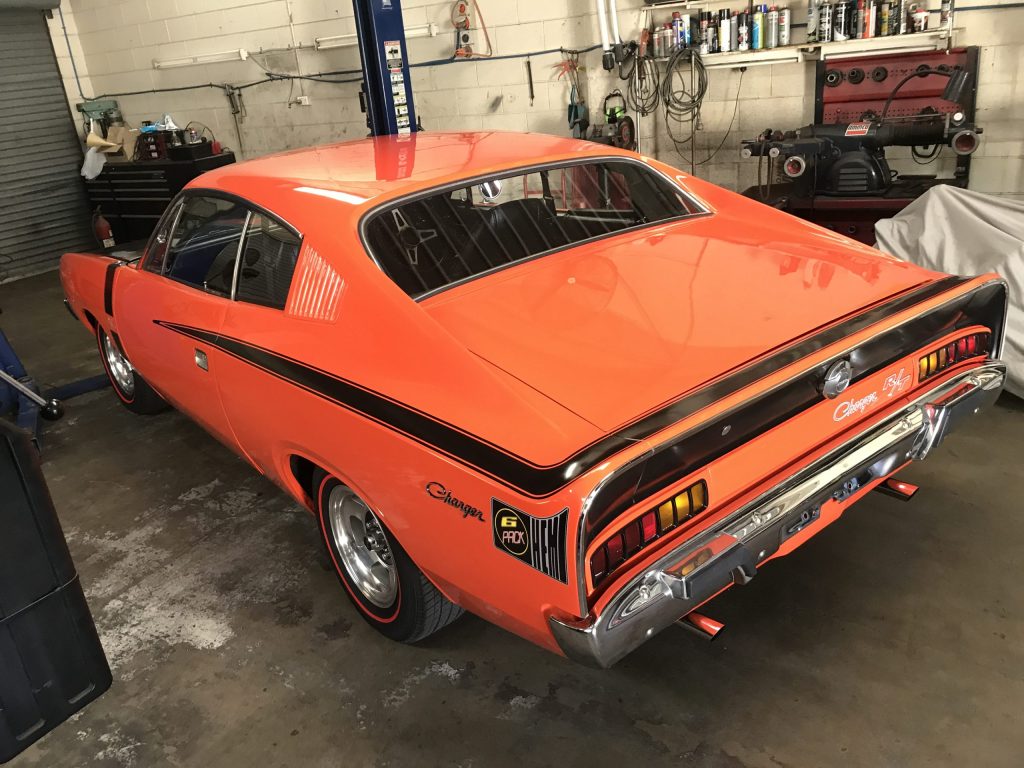Mad Max Replica
MAD MAX Interceptor Replica, Iconic co-star of the Aussie staged block buster movie franchise first released in 1979, that helped shape a generation and launched Mel Gibson to international stardom.
Guest starring with Gibson in the 1st feature film is the original incarnation of the Mad Max Interceptor Falcon Hardtop, as we see here today.
Based on a ’77 Ford XC Falcon Hardtop this Mad Max Interceptor was built by well known Kevin Bartlett race car builder Ron Eagle with advice from George Critty renowned Mad Max Expert and Consultant.
The car is powered by a 351 Cleveland V8 with 4 speed manual gearbox and features power steering, and A/C with a compressor that powers the blower belt. When you flick the switch on the gear stick the compressor is engaged and drives the blower pulley. Yes Max, a supercharger and she sucks nitro.
The supercharger, body kit and modified Sunraysia wheels were sourced through a West Australian based Mad Max specialist. And the working side pipes are music to a V8 lover’s ears as they cackle away right behind the big coupe’s cockpit windows.
This is an authentic build of an iconic Australian movie car and a great Aussie muscle car on super steroids.


Holden Monaro 327
The Holden Monaro 327, a revered and iconic muscle car, emerged from Holden’s pursuit of high-performance vehicles during the Australian automotive boom of the 1960s. Introduced in 1968, the Monaro 327 represented a significant milestone in Holden’s history and its commitment to delivering power, style, and performance.
The Monaro 327 was the top-tier variant within the Monaro lineup. Its name, “327,” was derived from the Chevrolet-sourced 327-cubic-inch (5.4-liter) V8 engine that powered the car. This engine was a centerpiece of the Monaro 327’s performance, producing an impressive output of around 250 horsepower.
The 327-cubic-inch V8 engine was paired with a choice of transmissions, including a three-speed manual or a two-speed “Powerglide” automatic. This combination allowed drivers to unleash the Monaro’s power and experience thrilling acceleration on the open road.
Visually, the Monaro 327 showcased aggressive styling cues that set it apart from its siblings. It featured unique badges, a prominent hood scoop, and optional racing stripes, further accentuating its performance-oriented nature. The interior boasted a sporty and luxurious cabin, with features such as bucket seats, a center console, and a distinctive steering wheel.
The Holden Monaro 327 quickly earned a reputation as a formidable muscle car, revered for its powerful performance and timeless design. It made a significant impact in the Australian automotive scene and became a symbol of Australian motoring excellence.
This 327 is a beast, the twin 4-barrel carburettors on a hi-rise manifold generate so much power it will spin the wheels in all gears. You should have a special licence to even consider driving this animal. An amazing example of a truly iconic Australian muscle car.
Holden UQ Ute
The HQ Ute is an iconic utility vehicle that was produced by the Australian automaker, Holden, as part of the HQ series. The origin of the HQ Ute can be traced back to the 1970s when it was introduced as a versatile and practical workhorse for various industries and personal use.
Holden designed the HQ Ute to be a reliable and sturdy vehicle capable of handling a wide range of tasks. It featured a robust chassis and suspension setup, making it suitable for carrying heavy loads and traversing rough terrains. The Ute’s design offered a spacious cargo bed at the rear, providing ample space for transporting goods, equipment, or materials.
The HQ Ute was available with different engine options, including inline-six and V8 engines. These powerplants provided sufficient power and torque for both work and recreational purposes. Customers could choose from a range of trim levels and engine configurations to suit their specific needs and preferences.
In terms of design, the HQ Ute had a distinct Australian flair, reflecting the automotive trends of the era. It featured a boxy and angular body design, characterized by its squared-off front end and flatbed at the rear. The interior of the HQ Ute offered a functional and straightforward layout, with durable materials and practical features suitable for a utility vehicle.
The HQ Ute quickly gained popularity in Australia, becoming a common sight on construction sites, farms, and as a personal vehicle for those seeking a versatile and dependable ride. Its ability to handle various tasks and its durability made it a trusted companion for many Australians in different industries.
The HQ Ute holds a special place in Australian automotive culture, representing a chapter in Holden’s history when utility vehicles played a significant role in the country’s workforce and lifestyle. It showcased Holden’s commitment to providing vehicles that met the demands of the Australian market.

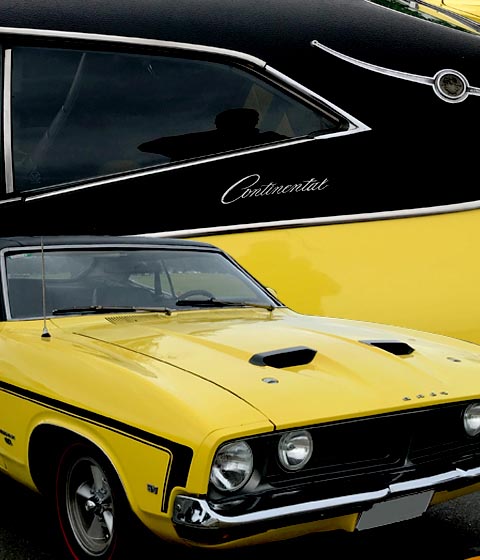
Ford XB Falcon Continental
The origin of the XB Falcon 2-Door Hardtop can be traced back to the development of the XB Falcon line-up, which was introduced in 1973 as a successor to the XY Falcon. The 2-door hardtop variant was a standout within the range, featuring a sleek and aggressive design that captured the attention of automotive enthusiasts.
What distinguished the XB Falcon 2-Door Hardtop with a Continental Vinyl Roof was the addition of the distinctive vinyl roof option and continental badging. It added a touch of elegance and luxury to the car’s exterior, giving it a distinct and sophisticated appearance.
Under the hood, the XB Falcon 2-Door Hardtop offered a range of engine options to cater to different performance preferences. These included powerful V8 engines, such as the 302-cubic-inch (4.9-liter) and 351-cubic-inch (5.8-liter) V8 engines. These engines provided impressive power output and exhilarating acceleration, delivering a thrilling driving experience.
Inside, the 2-door hardtop featured a driver-focused cockpit with comfortable seating and a range of optional features. It combined performance-oriented design elements with amenities and creature comforts to provide a balanced driving experience.
Build spec and numbers provided by Ford Australia
| Ford XB Falcon 2 Door Hardtop | |
| Description Total | Total |
| Total Build | 5350 |
| Engine: | 2844 |
| Transmission: | 1510 |
| Paint: | 184 |
| Trim: | 96 |
| Options: | 4 |
| Continental Vinyl Roof | 1 |
To our knowledge it is the only one built with its unique options and 1 of 12 surviving continentals with different options in Australia
Holden SLR
The Holden SLR is an iconic Australian automobile that played a significant role in the country’s automotive history. The “SLR” stands for “Sports and Luxury Road,” reflecting the car’s blend of performance and comfort. The most famous version of the Holden SLR was based on the Holden Torana model.
The story of the Holden SLR begins in 1969 when the Holden Torana was introduced as a compact car model by the Australian automaker, Holden. The Torana was designed to compete with other small cars of the era and was available in various body styles, including sedan, coupe, and wagon.

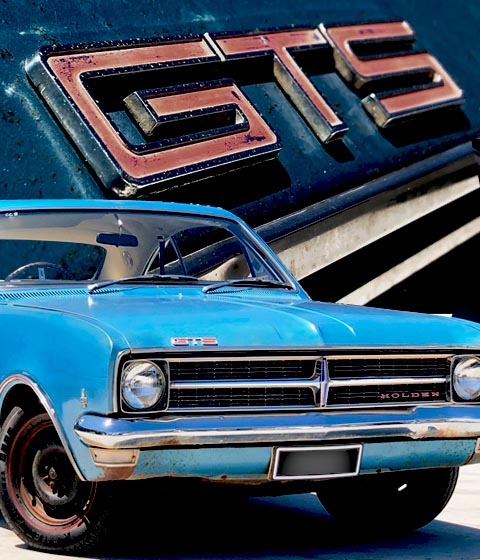
Monaro HK 186S GTS
The Holden 186S GTS, a legendary vehicle in Australian automotive history, originated from the renowned Australian automaker, Holden. Introduced in 1967 the 186 GTS represented a significant milestone in the evolution of Holden’s performance-oriented line-up.
At the heart of the 186 GTS was a 186-cubic-inch (3.0-liter) inline-six engine, delivering impressive power and torque. This engine was equipped with a dual-barrel Stromberg carburetor and a high-performance camshaft, resulting in an exhilarating driving experience. Paired with a robust suspension setup and upgraded braking system, the 186 GTS offered exceptional handling and precise control on the road.
Visually, the 186 GTS boasted distinctive styling cues that set it apart from the standard models. It featured unique badges, side striping, and luxurious interior appointments, showcasing its status as a performance-oriented variant within the EH line-up.
The Holden 186 GTS quickly gained popularity among automotive enthusiasts in Australia, thanks to its combination of performance, style, and affordability. It became a symbol of Australian muscle cars and represented the aspirations of many drivers seeking a thrilling driving experience on local roads.
This car has a colourful history 36,668 original miles travelled. Driven by the original owner and his wife until they passed away. Ownership of the vehicle transferred to their son who lent the car to a pair of country nuns who drove the car until approximately 1981 when it was noticed that the registration had expired in 1979 and the car was taken off the road and parked in a hay shed in St. George, Western QLD.
The car was then purchased by the current owner in 2010 and a Couplertec electronic rust protection unit fitted and was then stored in a shed inside a Cocoon airflow storage system until now. Features/options;186S motor, 4-speed manual transmission, Holden factory air conditions unit
Holden HX Monaro GTS TWD
The 1977 Holden HX GTS TWD Manual Sedan has a rich origin rooted in the Australian automotive industry. As part of the HX series, the HX GTS TWD (Two-Wheel Drive) Manual Sedan represented an evolution of the popular Holden muscle car line.
Holden, an Australian automaker, introduced the HX series in 1976 as the successor to the HJ series. The HX GTS TWD Manual Sedan was a high-performance variant within this lineup. It was designed to offer a balance of power, handling, and style, catering to enthusiasts seeking a thrilling driving experience.
Under the hood, the HX GTS TWD Manual Sedan featured a range of engine options. The most notable powerplant was the 5.0-liter V8 engine, delivering potent performance and a characteristic V8 exhaust note. With a manual transmission, drivers had full control over gear changes, adding to the engaging driving experience.
Visually, the HX GTS TWD Manual Sedan showcased a muscular and sporty design. It featured bold lines, a distinctive front grille, and unique badging, emphasizing its performance-oriented nature. The interior offered a combination of comfort and driver-focused features, with supportive seats, a sport steering wheel, and an array of gauges and controls.
The HX GTS TWD Manual Sedan’s handling characteristics were enhanced through suspension tuning and a well-balanced chassis. It offered precise steering and responsive handling, ensuring an enjoyable and dynamic driving experience both on straight roads and through corners.
The HX GTS TWD Manual Sedan was a popular choice among Australian car enthusiasts, showcasing the country’s love for powerful and stylish muscle cars. It represented a time when Holden was at the forefront of the Australian automotive industry, offering vehicles that captured the spirit of the era.
Today, the HX GTS TWD Manual Sedan holds a special place in Australian automotive history and is highly sought after by collectors and enthusiasts. It represents an era when performance and style were paramount, embodying the passion and craftsmanship that made Holden a respected name in the industry.

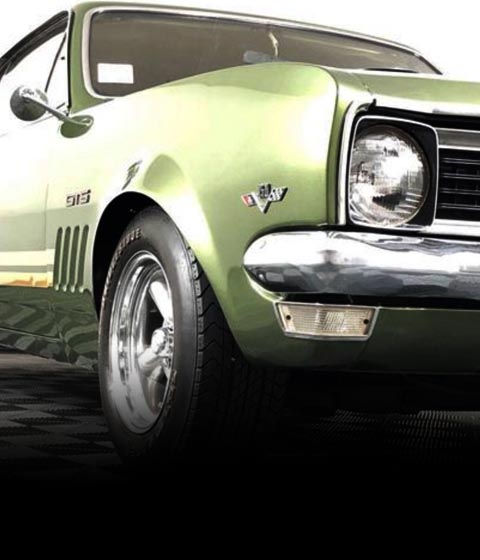
Holden Monaro HT GTS 350
The Holden Monaro 350 is an iconic Australian muscle car that originated from the collaboration between General Motors’ Australian subsidiary, Holden, and the American automaker, Chevrolet. The Monaro is a two-door coupe known for its powerful performance and striking design.
The origin of the Holden Monaro 350 can be traced back to the early 1960s when the first generation of the Monaro was introduced. It was inspired by the Holden HK series and was initially offered with a range of engine options, including six-cylinder and V8 engines. The Monaro quickly gained popularity for its stylish appearance and exceptional performance capabilities.
In the late 1960s, the Monaro underwent a transformation with the introduction of the second generation, known as the HQ Monaro. It was during this period that the Monaro 350 was born. The Monaro 350 was powered by a 350-cubic-inch (5.7-liter) V8 engine, which delivered impressive horsepower and torque figures. This robust powerplant provided exhilarating acceleration and a thrilling driving experience.
The Monaro 350 featured a sleek and aggressive design that captured the attention of automotive enthusiasts. It had a distinctive front grille, muscular lines, and a low-slung profile that exuded a sense of performance and power. The interior of the Monaro 350 offered comfort and style, with supportive seats, a sporty steering wheel, and a range of modern features and amenities.
The Holden Monaro 350 achieved significant success in motorsport events, including the famous Bathurst 1000 race. It became a symbol of Australian automotive performance and a cherished part of Holden’s heritage.
This car is one of the 680 that were required to be built for a car to race in Bathurst. the wheel arches were flared very early it its life this 350 has been painstakingly rebuilt to original specs ,motor has been blueprinted the interior has had some work to the front seats but apart from that it is as original as possible.
Holden Torana SLR 5000
In 1972, Holden introduced the Torana SLR 5000, a high-performance variant of the Torana model. The “SLR” stood for “Sports and Luxury Road,” while the “5000” denoted the car’s powerful 5.0-liter V8 engine. The Torana SLR 5000 was designed to offer a blend of sportiness and comfort, appealing to both driving enthusiasts and those seeking a more luxurious experience.
The Torana SLR 5000 was equipped with a 5.0-liter V8 engine that delivered impressive power for its time. This engine, coupled with performance enhancements like upgraded suspension and brakes, made the car well-suited for both the road and the track. The exterior featured distinctive styling cues, including bold stripes and decals, that set it apart from other Torana models.
The Torana SLR 5000 became an iconic representation of Australian muscle cars and automotive culture during the 1970s. Its dominance in motorsport and its striking design made it a coveted vehicle among car enthusiasts. The car’s success on the racetrack also contributed to its popularity among the general public.
The car remains a symbol of a bygone era when Australian muscle cars ruled the roads and tracks. Its significance in Australian automotive history and its impact on motorsport culture continue to be celebrated by enthusiasts and collectors. Today, well-preserved examples of the Torana SLR 5000 are highly sought after, serving as a nostalgic reminder of the golden age of Australian muscle cars.


Holden Monaro HQ
The Holden Monaro HQ was introduced in 1971 as part of the second generation of Monaro models. The HQ series represented a significant update over the previous generation and was designed to meet evolving market demands and regulatory requirements.
The Monaro HQ featured a more squared-off and aggressive design compared to its predecessor. It was available in various body styles, including coupe, sedan, and wagon. The coupe body style was particularly popular due to its sporty and stylish appearance. The Monaro HQ incorporated design elements that were in line with the aesthetic trends of the early 1970s.
The Monaro HQ offered a range of engine options, including inline-six and V8 engines. The V8 engines were particularly popular among enthusiasts, as they provided the power and performance that the Monaro was known for. These engines were mated to manual or automatic transmissions, providing customers with a choice of driving experiences.
The Monaro HQ became an iconic representation of Australian muscle cars during the 1970s. Its striking design, powerful engines, and motorsport achievements solidified its place in Australian automotive culture. The Monaro HQ was revered not only for its performance but also for its embodiment of the era’s automotive spirit.
Holden Monaro LS Coupe
The HJ Monaro LS coupe is close to being the rarest regular production car ever made in Australia with only 337 units produced. The HJ Monaro GTS coupe was discontinued during 1975 due to falling demand with only 606 GTS examples having been produced.
The Holden Monaro coupé was manufactured by General Motors Holden in Australia from 1968 to 1975 and later reintroduced from 2001 to 2005. It was also manufactured as a 4-door sedan from 1973 to 1977.
By 1975 the Monaro has been around for a few years now and had sported 2 main body styles the first with the HK , HT ,HG shape then the next version with the HQ and the HJ style.
A heavy facelift and some model rationalisation was applied to the HJ Monaro. The 350 V8 engine option and the base Monaro coupe were both discontinued.
The Monaro GTS continued to be available as a coupe or sedan with 253 cu in (4,150 cc) V8 power, or the optional 308 cu in (5,050 cc) V8 engine. The GTS sedan was now a model of its own—in HQ the GTS sedan was an optioned Kingswood. The Monaro LS coupe also continued within the range, but still with the 3.3-litre six-cylinder engine as its base power unit.
The body paint-outs were discontinued in the HJ Monaro GTS range, but for the first time, the Monaro could be dressed up with optional front and rear spoilers. It seemed that Holden were no longer interested in promoting the Monaro GTS coupe as a performance machine and this became all the more obvious with the HJ coupe series having retained the HQ model’s rear body styling.
This unicorn LS Monaro coupe is factory throughout.
Still sporting its original paint job and hubcaps, this true survivor car is so close to how it rolled of the production line.
Holden’s vision for this model was luxury and as you look at its lines the luxury interior and a grill that screams quality they certainly achieved it.
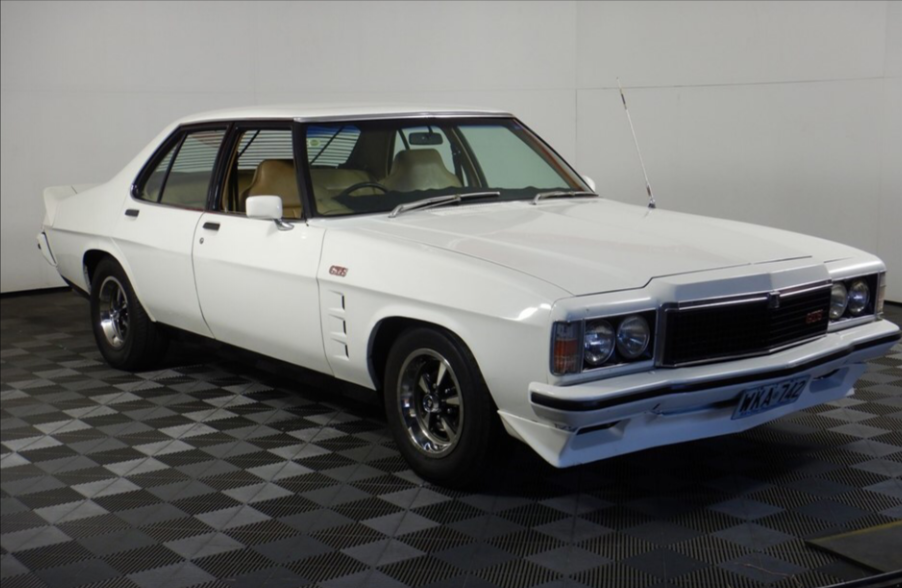

Holden FJ
The Holden FJ, an iconic Australian automobile, traces its origin back to the post-World War II era, when Holden sought to create a car that would meet the demands of Australian drivers and contribute to the country’s growing automotive industry. Introduced in 1953, the FJ became a symbol of Australian automotive ingenuity and resilience.
The origin of the Holden FJ can be attributed to its predecessor, the Holden FX, which was the first car to be produced by General Motors-Holden in Australia. The FX, released in 1948, marked a significant milestone as the first mass-produced car designed and manufactured entirely in Australia. Building on the success of the FX, Holden aimed to further refine and improve its offering, resulting in the development of the FJ.
The Holden FJ featured a range of updates and enhancements over its predecessor. It boasted a more robust chassis, improved suspension, and a revised front grille, giving it a fresh and distinctive appearance. The FJ retained the FX’s durable and reliable 2.2-liter inline-six engine, which provided sufficient power for daily driving and ensured longevity.
This brilliant example of Australian history is one of the first limousines ,featuring the covered rear wheel arches and so much chrome it sparkles like a diamond .Reserved for dignitaries and government officials this machine hat its own driver who picked up their passenger in the highest luxury available at the time .
Truly an icon of our past
Holden FX
The Holden FX, an iconic Australian automobile, emerged from the vision and determination of General Motors-Holden to create a car specifically tailored for Australian conditions and preferences. Introduced in 1948, the FX represented a significant milestone in Australian automotive history and became a symbol of post-war recovery and national pride.
The origins of the Holden FX can be traced back to the aftermath of World War II, when Australia experienced a surge in demand for affordable, locally produced cars. General Motors-Holden seized this opportunity and embarked on the ambitious project of developing a car entirely designed and manufactured in Australia. The result was the Holden FX, named after its project code, “FX-48.”
The Holden FX was the first mass-produced car designed and manufactured in Australia, heralding a new era in the country’s automotive industry. It was crafted to meet the unique requirements and preferences of Australian drivers, taking into account the country’s diverse geography and challenging road conditions.
Under the hood, the Holden FX featured a 2.2-liter inline-six engine, which provided a balance of power and efficiency suitable for Australian roads. Its robust construction and reliable performance made it well-suited for both urban commuting and long-distance travel.


Ford Falcon XY GT Replica
The Ford Falcon GT XY holds a special place in Australian automotive history as a legendary muscle car that emerged in the late 1960s. Its origin can be traced back to the XY Falcon, which was introduced in 1970 as an updated version of the previous XW Falcon.
The Falcon GT XY was a performance-oriented variant of the XY Falcon, aimed at capturing the attention of driving enthusiasts. It featured a powerful engine, aggressive styling, and enhanced performance components that set it apart from the standard Falcon models.
Under the hood, the Falcon GT XY boasted a 351-cubic-inch (5.8-liter) V8 engine, commonly known as the “Cleveland ” engine. This potent powerplant delivered impressive horsepower and torque, providing exhilarating acceleration and a thrilling driving experience. It was coupled with a four-speed manual transmission or an optional three-speed automatic transmission, offering drivers a range of choices.
Visually, the Falcon GT XY featured distinctive design elements that showcased its performance pedigree. It had a bold and muscular appearance, with a unique front grille, GT badging, and dual exhausts. Optional features like racing stripes and spoilers further enhanced its aggressive stance and aerodynamic profile. And don’t forget the shaker air intake that climes out of the bonnet that makes this possibly the most iconic and sought-after car in Australia
Inside the Falcon GT XY, the focus was on combining comfort with a sporty driving experience. The interior featured supportive bucket seats, a sports steering wheel, and a range of performance-oriented instruments and controls.
The Falcon GT XY quickly gained a reputation for its impressive performance and became an icon of Australian muscle cars. It earned success in various motorsport events, including the famous Bathurst 1000 race, further solidifying its reputation as a formidable performance machine.
This car is a replica GTHO Blueprinted engine and all new suspension, gearbox and diff. it drives as a brand-new GT should. Sadly, the donor shell came from a 6-cylinder car.
Ford Rhino 351-GT
The “351” refers to the displacement of the engine in cubic inches. Ford has produced several versions of the 351 V8 engine over the years, including the Windsor and Cleveland variants. These engines were known for their performance and were used in various Ford models.
The 351 Windsor V8, for instance, was used in several Ford vehicles including the Ford Mustang, Ford Bronco, and Ford F-Series trucks. It was offered in different configurations with varying power outputs, and it played a significant role in Ford’s performance-oriented lineup.
The “GT” branding has been used by Ford to designate high-performance models. One of the most famous examples is the Ford GT40, a series of race cars that dominated the 24 Hours of Le Mans endurance race in the 1960s. In recent times, Ford introduced the Ford GT supercar, paying homage to the original GT40 and showcasing advanced performance and technology.


Valiant Charger - Auto
The Valiant Charger was introduced by Chrysler Australia in 1971 as a variant of the Valiant model line. It was designed to compete with other muscle cars of the era, offering a combination of performance and style that appealed to Australian car enthusiasts.
The Valiant Charger was known for its unique design, featuring a fastback body style that set it apart from other cars on the road. Its sleek and aggressive appearance made it an instant head-turner. The Charger’s design was characterized by its bold lines, shapely rear end, and sporty aesthetics.
The Valiant Charger became a symbol of Australian muscle car culture during the 1970s. Its distinctive design and impressive performance characteristics captured the spirit of the era. The Charger’s appeal extended beyond performance enthusiasts, making it a cultural icon that resonated with a wide audience.
Despite its relatively short production run, the Valiant Charger left a lasting impact on Australian automotive history. Economic and regulatory changes in the mid-1970s, including the oil crisis, led to a shift in consumer preferences and eventually the discontinuation of the Valiant Charger in the late 1970s. The Charger’s legacy, however, lives on through its influence on automotive design and the nostalgia it evokes among car enthusiasts.
The Valiant Charger remains a sought-after collector’s item today, celebrated for its unique design, performance pedigree, and place in Australian automotive culture. Please note that developments beyond September 2021 are not included in this history.
Charger 770 R/T Manual
The Charger 770 R/T Manual is a variant of the Dodge Charger, a legendary American muscle car that traces its roots back to the mid-1960s. The Charger has established a reputation for its aggressive design, powerful performance, and thrilling driving experience.
The origin of the Charger 770 R/T Manual can be traced to the second generation of the Dodge Charger, which was produced from 1968 to 1970. The Charger R/T, short for Road/Track, was a high-performance trim level that showcased the Charger’s capabilities on both the road and the track. The 770 designation referred to the premium amenities and features that were offered with this variant.
The Charger 770 R/T Manual was equipped with a range of powerful 6 CYL and V8 engines, including options like the iconic 265 , 440 Magnum and the monstrous 426 Hemi. These engines were mated to a manual transmission, providing drivers with full control over gear changes and a more engaging driving experience.
In terms of design, the Charger 770 R/T Manual featured a distinctive and aggressive appearance that defined the muscle car era. It had a long, sculpted hood, a fastback roofline, and bold lines that exuded a sense of power and speed. The R/T badging and unique styling cues, such as a blacked-out grille and hood scoops, distinguished it as a performance-oriented machine.
Inside the cabin, the Charger 770 R/T Manual offered a driver-focused layout with sporty accents and premium materials. It featured bucket seats, a center console, and an array of gauges and controls, providing a cockpit-like experience. The 770 trim level added luxurious touches like upgraded upholstery and additional comfort features.
The Charger 770 R/T Manual epitomized the fusion of performance and style that made the Charger a beloved classic. Its manual transmission allowed enthusiasts to fully harness the power of the Charger’s high-performance engines, delivering an exhilarating driving experience.
